Cabin Fever shakes up the spring
by joey |
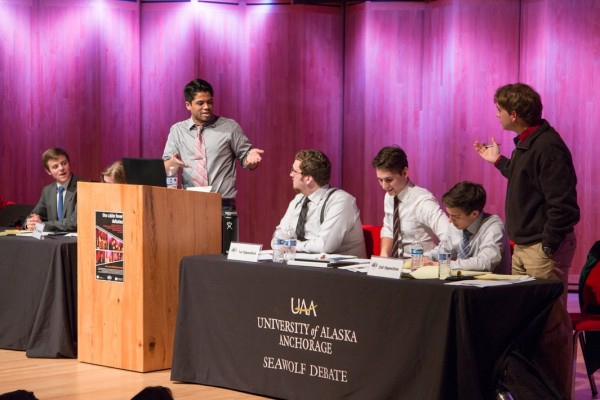
Jacob Tatum, at the podium, faces down the opposition side of the house in the finals of this year's Cabin Fever Debates. (Photo by Jacob Shercliffe, Seawolf Debate)
Like nearly every American university, UAA offers a variety of intramural sports for its students. Unlike nearly everywhere else, UAA also offers intramural debate.
"As far as I know, we're the only university in the nation that does an intramural tournament of this scale," Steve Johnson explained of the annual Cabin Fever Debates. And he would know. For the past 20 years, he's coached Seawolf Debate to the top of the international standings. In all those years, against all those teams, he hasn't heard of an intramural scene like UAA's. "I think we're pretty much alone in doing this," he acknowledged.
This year's Cabin Fever tournament wrapped on Thursday, March 10. Roughly 150 people filled both levels of the Recital Hall in the Fine Arts Building as eight students discussed the merits of concealed carry on campus. It's hard to imagine any other university nets as large of an audience for an intramural event. Anchorage just loves a good debate.
A recipe for Cabin Fever
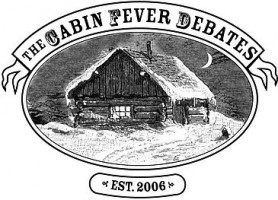
Image courtesy of Seawolf Debate
Cabin Fever Debates launched in 2006 and, after 11 tournaments, the intramural competition has solidified itself as a spring fixture on campus.
The event started simply as a way to increase debate on campus. It gave the often-traveling Seawolf Debate team a presence at home, encouraged student involvement and served as a recruiting tool for the squad. There was also one more motivator; "I just really like watching debates," Steve added.
But students weren't immediately sold on the idea. Public speaking? For fun? "Dentists, snakes and public speaking are right at the top of everybody's list of fears," Steve laughed. "We were dragging people kicking and screaming that first year."
Seawolf Debate team members can't compete in Cabin Fever (that would be like the women's basketball team steamrolling a 3-on-3 tourney in Wells Fargo) but they're still heavily involved in judging and convincing their friends to participate.
For the inaugural tournament in 2006, Seawolf Debate members shoved their roommates and significant others on stage to fill the bracket but, by 2008, enough folks registered of their own volition to fill a 32-team field. Now, students clamor for Cabin Fever; 100 students applied for the 2016 debates. "It didn't take long for it to really catch on," Steve added.
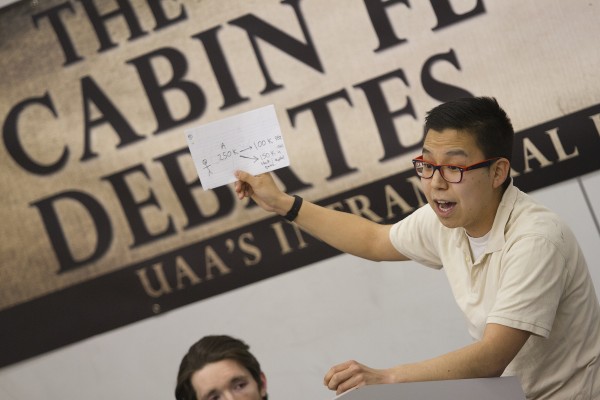
Finalist Tim Williams makes his case with a quick illustration at the semifinals. (Photo by Phil Hall / University of Alaska Anchorage)
March Madness
So what influences students to stand and sometimes stumble in front of their peers at Cabin Fever? For one, there's the cash incentive (finalists are guaranteed a $200 prize, semifinalists get $50 each). Then there's the potential for bumping up to varsity debate (half of Steve's traveling team started in Cabin Fever, including current assistant coach Amie Collins, who later placed in the top 20 at Worlds). And for those who can't commit to the demands of Seawolf Debate, Cabin Fever provides an annual fix for outsmarting and out-sassing opponents in the spotlight.
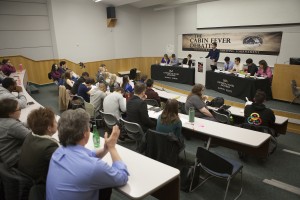
Even the six weeks of preliminary debates drew a late-night crowd. (Photo by Phil Hall / University of Alaska Anchorage)
The 6-week tournament runs through the front half of spring semester, concluding on the Thursday before Spring Break. A week in advance, each team learns the opinion they must vigorously defend regardless of their personal convictions (this year's issues ranged from statewide lotteries to presidential candidates to the moral implications of supporting an NFL team). Cabin Fever is daunting enough, so that one week of prep time provides a cozy security blanket (in contrast, other college tournaments provide only a few minutes between revealing the issue and starting the debate).
Four teams faced off in each round of verbal chess. Two teams argued for a motion and two against in a strategic blend of offense, defense and the ability to see counterarguments coming their way. After each round, judges determined the top teams of case-makers and eliminated the rest.
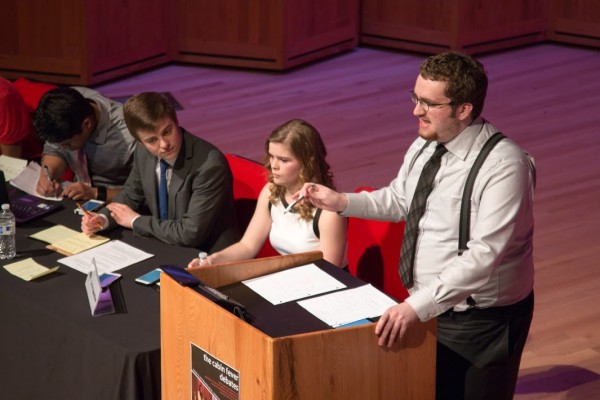
Sam Doepken stands at the podium while members of the proposition plot their counterarguments .(Photo by Jacob Shercliffe, Seawolf Debate)
The final four
After 10 rounds of preliminaries, the final four pairs took the stage of UAA's recital hall last Thursday to argue whether concealed carry firearms should be allowed on campus (this contentious and continuing issue was also argued at the 2010 Cabin Fever finals).
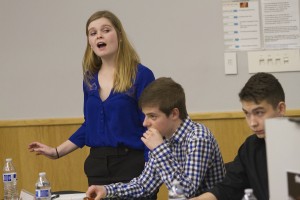
Sarah Gray, seen here at the semifinals, won the tournament's top speaker prize. (Photo by Phil Hall / University of Alaska Anchorage)
The final 50-minute debate drew a raucous crowd, who cordially thundered their approval with sharp raps on their armrests and occasional yelps of "Here, here" as the eight students on stage made remarks and rebuttals. A panel of judges-two Cabin Fever champs, two Seawolf Debate members, one national champion in Michael Rose, B.A. '09-awarded first-year student Sarah Gray the top speaker prize. The team trophy, though, went to Neal Koeneman and Sam Doepken for their arguments in favor of campus gun control.
"I think I averaged around $70 an hour for this one," Neal joked, balancing his $500 winnings against the amount of research he and Sam put in during the tournament.
All four teams put the work in to reach the finals, whether they were consulting Seawolf Debate team members or stopping by Steve's office. No matter their efforts, it was all essentially added homework in the pursuit of academic intramural glory.
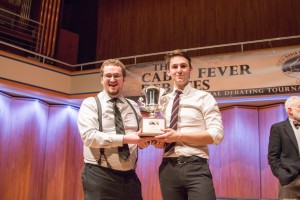
Sam Doepker, left, and Neal Koeneman took the title at the 2016 Cabin Fever Debates. (Photo by Jacob Shercliffe, Seawolf Debate)
"You got to admire the debate team and the work and effort it entails," said finalist Tim Williams.
What's next for Seawolf Debate?
Students filtered out of the Fine Arts Building around 9 p.m.-impressively late, considering it was most students' first night of Spring Break. But that's just another testament to the status of debate in Anchorage.
"I am so incredibly proud of both a program like this and student body like ours who will jump into something like [Cabin Fever]," Steve commented. "That's what a university is supposed to be, a place where people can get excited about doing things that improve themselves."
In Steve's eyes, this isn't something a business or non-profit could organize. An intramural debate tournament could only come from a university. "I love being part of something like that," he said.
Seawolf Debate takes on the best of the hemisphere from March 24-28 at the Pan-American Universities Debating Championship in Montego Bay, Jamaica.
And here in Anchorage, the Arguing Alaska series continues March 28 at Bear Tooth, where former Democratic Rep. Eric Croft and former Republican Senatorial candidate Joe Miller discuss campaign contribution caps. Event information here.
 "Cabin Fever shakes up the spring" is licensed under a Creative Commons Attribution-NonCommercial 4.0 International License.
"Cabin Fever shakes up the spring" is licensed under a Creative Commons Attribution-NonCommercial 4.0 International License.














